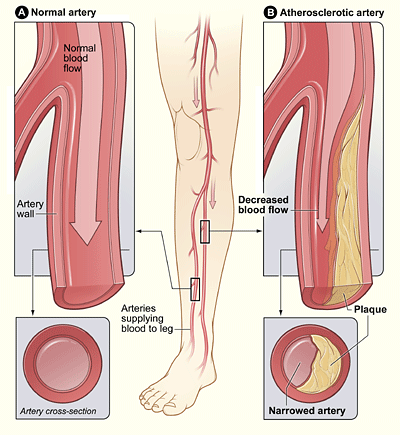Peripheral Artery Disease Operations
- Home
- Vascular Treatment
- Peripheral Artery Disease Operations

Peripheral Artery Disease
Peripheral Artery Disease (PAD) occurs when plaque, composed of fats and cholesterol, builds up in the arteries of the legs or arms. This build-up makes it difficult for the blood to effectively carry oxygen and nutrients to the tissues in those areas. PAD is a chronic condition, but it can be managed and improved with certain lifestyle changes.
Understanding Peripheral Artery Disease (PAD)
Peripheral Artery Disease (PAD) is a condition characterized by the accumulation of plaque within the arteries of the legs, which deliver oxygen and nutrient-rich blood from the heart to the arms and legs. This plaque, manufactured from fats, LDL cholesterol, and other materials, regularly narrows the arteries, decreasing blood drift to the affected areas. If the plaque or a blood clot in addition narrows or blocks the arteries, it could result in tissue damage and, in intense cases, tissue death, in particular in the toes and feet.
Managing PAD: PAD can be controlled and improved by means of making precise way of life modifications. Regular exercising, a diet low in fats and cholesterol, and giving up tobacco merchandise are crucial for coping with the condition. These measures can assist improve blood drift and flow, thereby decreasing the effect of PAD on daily lifestyles.
Vascular Surgeon in Vadodara (Rutvij Shah): For individuals seeking professional care and guidance for handling PAD, consulting a vascular healthcare professional in Vadodara, including Rutvij Shah, may be beneficial. Vascular surgeons are trained to diagnose and deal with conditions affecting the blood vessels, together with PAD. They can provide personalized remedy plans and interventions to assist in manipulating and enhancing the symptoms of PAD, making sure the choicest vascular fitness and common well-being.
In the end, Peripheral Artery Disease (PAD) entails the sluggish buildup of plaque in the arteries of the legs, main to decreased blood drift. By making lifestyle modifications and searching for the know-how of a vascular health practitioner in Vadodara, consisting of Rutvij Shah, individuals can effectively manipulate and enhance the effect of PAD on their daily lives.
-
How Common Is Peripheral Artery disease?
Peripheral Artery Disease (PAD) is common, affecting between eight and 12 million Americans. However, healthcare carriers now and again don’t diagnose or treat PAD enough. Actual numbers are possibly better.
-
What Are the Complication of Peripheral Artery disease ?
Without treatment, human beings with PAD may additionally want an amputation — the removal of part or all your foot or leg (not often your arm), especially in individuals who additionally have diabetes.
Because your body’s circulatory system is interconnected, the outcomes of PAD can expand beyond the affected limb. People with atherosclerosis of their legs regularly have it in different elements of their bodies. -
What Is the most Common Cause of Peripheral Artery disease?
Atherosclerosis that develops in the arteries of your legs — or, less usually, your palms — causes peripheral arterial disease. Like atherosclerosis in your heart (coronary) arteries, a group of fatty plaque to your blood vessel walls reasons peripheral vascular sickness. As plaque builds up, your blood vessels get narrower and narrower, until they’re blocked.
-
When Should I see my Healthcare Provider?
Contact your healthcare provider in case you:
Get a terrible infection in a sore on your foot. The infection can extend into your muscle groups, tissues, blood and bones. If your contamination is intense, you could want to go to the clinic.
Can’t stroll around sufficiently to do regular activities.
Have an ache to your legs while you’re resting. This is an indication of terrible blood waft. -
When Should I Go to the ER?
Get on the spot help if you can’t sense or move your foot or if it appears one-of-a-kind out of your different foot’s pores and skin colour. This method you’ve misplaced blood float on your leg without caution.
-
What questions Should I Ask My doctor ?
Do I need medications to reduce my risk of Peripheral Artery Disease ?
How far should I walk when I start a walking program?
Do I need surgical procedures for peripheral vascular disease?
